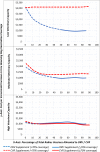Estimating the effectiveness of vaccine programs in dog populations
- PMID: 31364582
- PMCID: PMC6805755
- DOI: 10.1017/S0950268819001158
Estimating the effectiveness of vaccine programs in dog populations
Abstract
Dogs harbor numerous zoonotic pathogens, many of which are controlled through vaccination programs. The delivery of these programs can be difficult where resources are limited. We developed a dynamic model to estimate vaccination coverage and cost-per-dog vaccinated. The model considers the main factors that affect vaccination programs: dog demographics, effectiveness of strategies, efficacy of interventions and cost. The model was evaluated on data from 18 vaccination programs representing eight countries. Sensitivity analysis was performed for dog confinement and vaccination strategies. The average difference between modelled vaccination coverage and field data was 3.8% (2.3%-5.3%). Central point vaccination was the most cost-effective vaccination strategy when >88% of the dog population was confined. More active methods of vaccination, such as door-to-door or capture-vaccinate-release, achieved higher vaccination coverage in free-roaming dog populations but were more costly. This open-access tool can aid in planning more efficient vaccination campaigns in countries with limited resources.
Keywords: Modelling; rabies (animal); vaccination (immunisation); zoonoses.
Figures




Similar articles
-
Cost-Effectiveness of Mass Dog Vaccination Campaigns against Rabies in Flores Island, Indonesia.Transbound Emerg Dis. 2017 Dec;64(6):1918-1928. doi: 10.1111/tbed.12590. Epub 2016 Nov 23. Transbound Emerg Dis. 2017. PMID: 27878980
-
Costs and effectiveness of alternative dog vaccination strategies to improve dog population coverage in rural and urban settings during a rabies outbreak.Vaccine. 2020 Sep 3;38(39):6162-6173. doi: 10.1016/j.vaccine.2020.06.006. Epub 2020 Jun 29. Vaccine. 2020. PMID: 32616327
-
Implementation of a mass canine rabies vaccination campaign in both rural and urban regions in southern Malawi.PLoS Negl Trop Dis. 2020 Jan 23;14(1):e0008004. doi: 10.1371/journal.pntd.0008004. eCollection 2020 Jan. PLoS Negl Trop Dis. 2020. PMID: 31971943 Free PMC article.
-
Rationale and support for a One Health program for canine vaccination as the most cost-effective means of controlling zoonotic rabies in endemic settings.Vaccine. 2017 Mar 23;35(13):1668-1674. doi: 10.1016/j.vaccine.2017.02.014. Epub 2017 Feb 16. Vaccine. 2017. PMID: 28216188 Review.
-
Review on dog rabies vaccination coverage in Africa: a question of dog accessibility or cost recovery?PLoS Negl Trop Dis. 2015 Feb 3;9(2):e0003447. doi: 10.1371/journal.pntd.0003447. eCollection 2015 Feb. PLoS Negl Trop Dis. 2015. PMID: 25646774 Free PMC article. Review.
Cited by
-
Role of Oral Rabies Vaccines in the Elimination of Dog-Mediated Human Rabies Deaths.Emerg Infect Dis. 2020 Dec;26(12):1-9. doi: 10.3201/eid2612.201266. Emerg Infect Dis. 2020. PMID: 33219786 Free PMC article.
-
Review of Oral Rabies Vaccination of Dogs and Its Application in India.Viruses. 2022 Jan 14;14(1):155. doi: 10.3390/v14010155. Viruses. 2022. PMID: 35062358 Free PMC article. Review.
-
Willingness to vaccinate and willingness to pay for vaccination against peste des petits ruminants in northern Senegal.Front Vet Sci. 2024 Jun 26;11:1405073. doi: 10.3389/fvets.2024.1405073. eCollection 2024. Front Vet Sci. 2024. PMID: 38988983 Free PMC article.
-
Optimising rabies vaccination of dogs in India.Epidemiol Infect. 2023 Aug 22;151:e164. doi: 10.1017/S0950268823001334. Epidemiol Infect. 2023. PMID: 37606523 Free PMC article.
-
An implementation science framework to understand low coverage in mass dog rabies vaccination.PLoS Negl Trop Dis. 2025 Jul 23;19(7):e0012869. doi: 10.1371/journal.pntd.0012869. eCollection 2025 Jul. PLoS Negl Trop Dis. 2025. PMID: 40700444 Free PMC article.
References
-
- Montagu MF (1942) On the origin of the domestication of the dog. Science 96, 111–112. - PubMed
Publication types
MeSH terms
Substances
LinkOut - more resources
Full Text Sources
Medical
Miscellaneous

